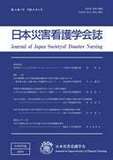Japanese
English
- 有料閲覧
- Abstract 文献概要
- 参考文献 Reference
要旨
本研究は、東日本大震災時の災害亜急性期に手術看護を経験した看護師が、どのような外回り看護を行ったかを明らかにすることを目的としたものである。調査は2012年4〜5月に行った。A県内の日本手術看護学会に登録している33病院の中から、津波の直接被害を受けた施設を除いた中からランダムに7病院を選択した。質問の内容は手術看護認定看護師会が作成した「患者の安全を守り、早期回復へ」という目標に向かい、外回り看護師が行っている看護の内容を分類し特性要因図に示したものを参考に構成した。項目ごとに平時と災害亜急性期の看護における対応の違いについて、内容の記入を依頼した。結果、災害亜急性期には「災害により及ぼされる患者への影響を最小限にする看護」と、「災害亜急性期の状況に応じた柔軟な対応」が平時と異なる外回り看護として行われていた。
This study aims to clarify what kinds of circulating nursing was carried out by surgery nurses who experienced sub-acute phases of disaster at the time of the Great East Japan Earthquake. The study was carried out in April and May 2012. Seven hospitals were randomly selected from a total of 33 Japan Operative Nursing Academy-registered hospitals in Prefeture A, excluding facilities that were directly damaged by the tsunami. The contents of the questions were structured in reference to the contents of nursing carried out by surgical nurses,which are classified and displayed on a fishbone diagram produced by a surgical-nursing-approved nursing association for the purpose of “the safe protection and speedy recovery of patients.”
Each item requests subjects to fill in details of the differences between nursing duties during normal times and those during sub-acute phases of disaster. The results indicate that during sub-acute phases of disaster, “nursing that minimizes the impact on patients affected by the damage” and “flexibility in dealing with situations in response to the circumstances of sub-acute phases of disaster” are different from the circulating nursing that takes place during normal times.
Copyright © 2014, Japan Society of Disaster Nursing All rights reserved.


